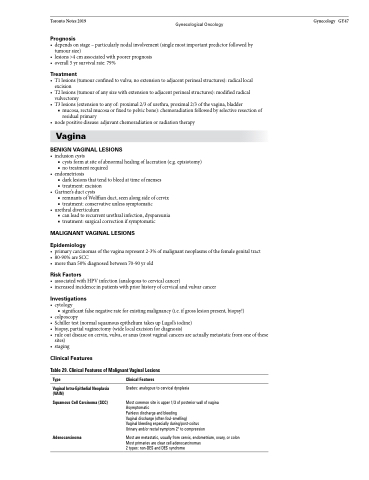Page 533 - TNFlipTest
P. 533
Toronto Notes 2019 Gynecological Oncology Gynecology GY47
Prognosis
• dependsonstage–particularlynodalinvolvement(singlemostimportantpredictorfollowedby tumour size)
• lesions>4cmassociatedwithpoorerprognosis
• overall5yrsurvivalrate:79%
Treatment
• T1lesions(tumourconfinedtovulva;noextensiontoadjacentperinealstructures):radicallocal excision
• T2lesions(tumourofanysizewithextensiontoadjacentperinealstructures):modifiedradical vulvectomy
• T3lesions(extensiontoanyof:proximal2/3ofurethra,proximal2/3ofthevagina,bladder
■ mucosa, rectal mucosa or fixed to pelvic bone): chemoradiation followed by selective resection of
residual primary
• nodepositivedisease:adjuvantchemoradiationorradiationtherapy
Vagina
BENIGN VAGINAL LESIONS
• inclusioncysts
■ cysts form at site of abnormal healing of laceration (e.g. episiotomy) ■ no treatment required
• endometriosis
■ dark lesions that tend to bleed at time of menses ■ treatment: excision
• Gartner’sductcysts
■ remnants of Wolffian duct, seen along side of cervix ■ treatment: conservative unless symptomatic
• urethraldiverticulum
■ can lead to recurrent urethral infection, dyspareunia ■ treatment: surgical correction if symptomatic
MALIGNANT VAGINAL LESIONS
Epidemiology
• primarycarcinomasofthevaginarepresent2-3%ofmalignantneoplasmsofthefemalegenitaltract • 80-90%areSCC
• morethan50%diagnosedbetween70-90yrold
Risk Factors
• associatedwithHPVinfection(analogoustocervicalcancer)
• increasedincidenceinpatientswithpriorhistoryofcervicalandvulvarcancer
Investigations
• cytology
■ significant false negative rate for existing malignancy (i.e. if gross lesion present, biopsy!)
• colposcopy
• Schillertest(normalsquamousepitheliumtakesupLugol’siodine)
• biopsy,partialvaginectomy(widelocalexcisionfordiagnosis)
• ruleoutdiseaseoncervix,vulva,oranus(mostvaginalcancersareactuallymetastaticfromoneofthese
sites)
• staging
Clinical Features
Table 29. Clinical Features of Malignant Vaginal Lesions
Type
Vaginal Intra-Epithelial Neoplasia (VAIN)
Squamous Cell Carcinoma (SCC)
Adenocarcinoma
Clinical Features
Grades: analogous to cervical dysplasia
Most common site is upper 1/3 of posterior wall of vagina Asymptomatic
Painless discharge and bleeding
Vaginal discharge (often foul-smelling)
Vaginal bleeding especially during/post-coitus Urinary and/or rectal symptom 2° to compression
Most are metastatic, usually from cervix, endometrium, ovary, or colon Most primaries are clear cell adenocarcinomas
2 types: non-DES and DES syndrome


